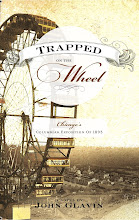
Below is our first review, from Dick Davidson's blog ReadWorthy Books:
"Trapped on the Wheel by John Glavin is a throwback to earlier times, both in the subject matter and in the graphics that decorate the book with the goal of making you want to give the book a permanent place on your library shelves. The reader faces the book's competing goals of historical re-creation of the Columbian Exposition of 1893, presentation of the social and ethical mores of the period, and engagement in the plot. The overall experience of reading this novel is a pleasant one, but the reader should plan on concentrating on the many details that are required to paint the historical panorama that is the backdrop for the story.
The plot is a coming of age story for two fraternal twins, Alessandra and Karla Aultman, who have just turned eighteen years of age. They have German/Irish background, and they live beyond their means in a row house with lots of servants. Their father, a real estate speculator, aspires to be in the top social echelon, but he is constantly on the brink of economic disaster. The story is a first person narrative from Alessandra's viewpoint, and she spends most of the book feeling insecure with regard to her relationships with her sister, her father, the servants, and her expected fiance.
John Glavin does a good job of capturing the slower pace of life among the elite during the 1890's. This contrasts well with the concurrent frenetic efforts to complete the structures and exhibits of the Columbian Exposition by any time close to the original schedule. As the story evolves, the action accelerates, evoking increased concern on the part of the reader for the heroine.
The first person narrative form allows the author to selectively reveal differences between what Alessandra perceives and what is actually happening around her. It suits this novel's plot."
ISBN 978-0-9822694-4-2
Reviewed by Richard Davidson, author of DECISION TIME! Better Decisions for a Better Life (self-help), author of Lead Us Not into Temptation (mystery novel).





